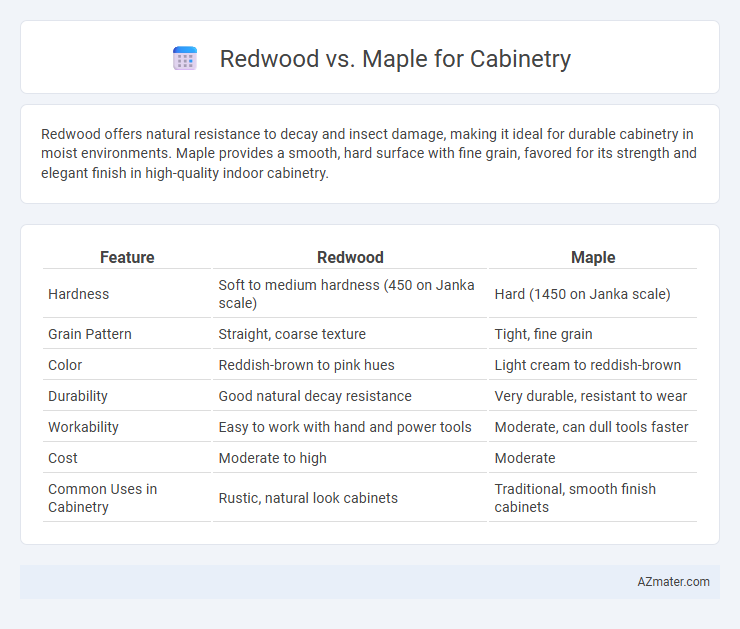Redwood offers natural resistance to decay and insect damage, making it ideal for durable cabinetry in moist environments. Maple provides a smooth, hard surface with fine grain, favored for its strength and elegant finish in high-quality indoor cabinetry.
Table of Comparison
| Feature | Redwood | Maple |
|---|---|---|
| Hardness | Soft to medium hardness (450 on Janka scale) | Hard (1450 on Janka scale) |
| Grain Pattern | Straight, coarse texture | Tight, fine grain |
| Color | Reddish-brown to pink hues | Light cream to reddish-brown |
| Durability | Good natural decay resistance | Very durable, resistant to wear |
| Workability | Easy to work with hand and power tools | Moderate, can dull tools faster |
| Cost | Moderate to high | Moderate |
| Common Uses in Cabinetry | Rustic, natural look cabinets | Traditional, smooth finish cabinets |
Introduction to Redwood and Maple for Cabinetry
Redwood and maple are popular hardwoods used in cabinetry, each offering distinct characteristics suited for different design preferences. Redwood features a rich reddish hue with natural resistance to decay and insects, making it ideal for rustic or outdoor-inspired cabinetry. Maple, known for its fine, consistent grain and light color, provides a smooth finish and exceptional durability, making it a versatile choice for modern and traditional cabinetry styles.
Wood Characteristics: Redwood vs Maple
Redwood offers a distinct reddish hue, natural resistance to decay, and a softer texture that makes it easy to work with but less durable under heavy use. Maple features a light, creamy color with a fine, uniform grain pattern, known for its hardness and resistance to denting, making it ideal for high-traffic cabinetry. Both woods provide unique aesthetic and functional qualities, with redwood best suited for rustic designs and maple preferred for sleek, modern cabinetry.
Appearance and Grain Patterns
Redwood cabinetry showcases a rich, reddish-brown hue with pronounced, straight grain patterns that add warmth and character to interiors. Maple offers a lighter, creamy color with subtle, fine grain variations, making it ideal for a smooth, clean look in cabinetry. The distinct grain patterns of redwood provide a rustic feel, while maple's uniform texture suits more contemporary or refined design styles.
Durability and Longevity Comparison
Redwood offers moderate durability with natural resistance to decay and insect damage, making it suitable for indoor cabinetry but less ideal for heavy-use areas due to its relatively softer grain. Maple stands out for its exceptional hardness and density, providing superior scratch and dent resistance, which enhances the longevity of cabinets in high-traffic environments. Choosing maple ensures a longer lifespan and better resilience under frequent use compared to redwood.
Workability and Ease of Crafting
Redwood offers superior workability with its soft texture, making it easier to cut, shape, and sand for detailed cabinetry designs. Maple, being a hardwood, is denser and more challenging to craft but provides a smooth finish and exceptional durability. Woodworkers often prefer redwood for quicker projects, while maple is chosen for long-lasting, high-quality cabinetry requiring precise craftsmanship.
Cost Differences Between Redwood and Maple
Maple cabinetry typically costs between $150 and $300 per cabinet due to its durability and smooth grain, making it a popular mid-range wood option. Redwood, priced higher at approximately $200 to $400 per cabinet, commands a premium for its rich color and natural resistance to moisture and decay. The cost difference between redwood and maple largely reflects redwood's superior resistance properties and aesthetic appeal, which may increase upfront investment but enhance long-term durability in cabinetry applications.
Maintenance and Care Requirements
Redwood cabinetry requires minimal maintenance due to its natural resistance to decay and insects, making it ideal for environments prone to moisture. Maple, while durable and smooth, demands regular sealing and occasional refinishing to prevent surface damage and maintain its polished appearance. Both woods benefit from gentle cleaning with mild soap and water, but maple's tighter grain necessitates more consistent upkeep to avoid staining and warping.
Environmental Impact and Sustainability
Redwood and maple differ significantly in environmental impact and sustainability when used for cabinetry. Redwood is a softwood that grows relatively quickly and is often sourced from sustainable forests certified by organizations like the Forest Stewardship Council (FSC), making it a more renewable option with lower embodied carbon. Maple, a hardwood, grows slower and is more energy-intensive to process, but its durability and long lifespan can offset its initial environmental footprint in cabinetry applications.
Popular Uses and Design Styles
Redwood is favored for cabinetry in rustic, outdoor, and coastal design styles due to its natural insect resistance and rich reddish hue, making it ideal for adding warmth and durability in moist environments. Maple, known for its smooth grain and light, uniform color, is popular in modern, contemporary, and transitional cabinetry where a sleek, clean look is desired. Both woods are highly versatile, with redwood often used in outdoor kitchens and custom rustic cabinets, while maple excels in cabinetry requiring fine detail and a polished finish.
Choosing the Right Wood for Your Cabinetry
Redwood offers a unique warm hue and natural resistance to decay, making it ideal for cabinetry in humid environments, while maple features a smooth grain and superior durability, perfect for high-traffic areas requiring long-lasting surfaces. Maple's lighter tone and adaptability to staining provide versatility in design, contrasting with redwood's rich reddish-brown color that enhances rustic or natural aesthetics. Consider factors like moisture exposure, design preferences, and maintenance needs when choosing between redwood and maple for cabinetry to ensure optimal durability and appearance.

Infographic: Redwood vs Maple for Cabinetry
 azmater.com
azmater.com